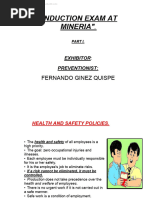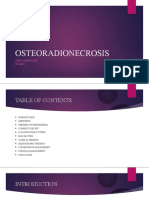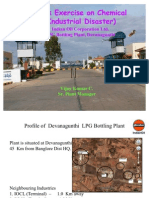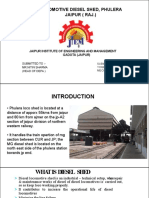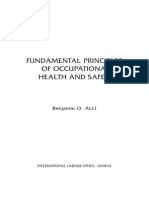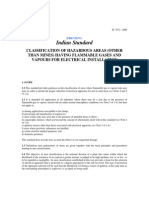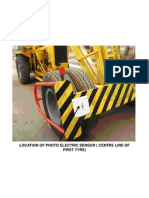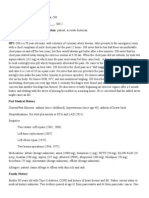Auto Repair Man Hazards
Auto Repair Man Hazards
Uploaded by
dogankkuCopyright:
Available Formats
Auto Repair Man Hazards
Auto Repair Man Hazards
Uploaded by
dogankkuCopyright
Available Formats
Share this document
Did you find this document useful?
Is this content inappropriate?
Copyright:
Available Formats
Auto Repair Man Hazards
Auto Repair Man Hazards
Uploaded by
dogankkuCopyright:
Available Formats
International Hazard Datasheets on Occupation
Mechanic, automobile
What is a Hazard Datasheet on Occupation?
This datasheet is one of the International Datasheets on Occupations. It is intended for those professionally concerned with health and safety at work: occupational physicians and nurses, safety engineers, hygienists, education and Information specialists, inspectors, employers ' representatives, workers' representatives, safety officers and other competent persons. This datasheet lists, in a standard format, different hazards to which mechanic, automobiles may be exposed in the course of their normal work. This datasheet is a source of information rather than advice. With the knowledge of what causes injuries and diseases, is easier to design and implement suitable measures towards prevention. This datasheet consists of four pages: Page 1: Information on the most relevant hazards related to the occupation. Page 2: A more detailed and systematized presentation on the different hazards related to the job with indicators for preventive measures (marked as numbered shields and explained on the third page). Page 3: Suggestions for preventive measures for selected hazards. Page 4: Specialized information , relevant primarily to occupational safety and health professionals and including information such as a brief job description, a list of tasks, notes and references.
Who is an automobile mechanic?
A worker who repairs and overhauls cars and other automotive vehicles, or their systems and parts. He/she examines them, makes necessary repairs, replacements, adjustments, and presents the repaired vehicle to his/her superior or to the customer.
What is dangerous about this job?
Automobile mechanics usually work in service garages where they may fall from ladders, stairs or elevated platforms, fall into inspection pits, trip or fall on wet, slippery or greasy floors. Automobile mechanics may be severely injured by faulty garage equipment such as jacks or lifts, by moving vehicles, by heavy parts falling on their feet or by bursting tires. Automobile mechanics often handle heavy vehicle parts and work in awkward postures which may lead to trauma such as disk rupture or hernia and disabling back pains. The automobile mechanics' work place contains many hazards which can lead to accidents resulting in burns, punctures cuts, and electrocution.
International Hazard Datasheets on Occupation Mechanic, automobile
Page 2 of 4
Hazards related to this job
Accident hazards Falls from ladders, stairs, elevated platforms etc., and falls into inspection pits Falls on the level, esp. on wet, slippery or greasy garage floors Injuries due to collapse of jacking, lifting or hoisting equipment, and vehicles falling from lifting equipment them Crushed toes resulting from falls of heavy objects Eye injury from splinters and flying objects from grinding, and machining operations, while operating compressed-air equipment and during cleaning and similar operations Injuries as a result of being caught in or between moving and stationary objects Injuries caused by rotating parts of machine tools Acute musculoskeletal injuries (intervertebral disk rupture, hernia etc.) due to overexertion while lifting or otherwise handling heavy vehicle parts, etc., and due to awkward work postures (underneath vehicle, etc.) Burns due to contact with hot surfaces, exhaust pipes or hot-melt chemicals; sudden release of hot water and steam lines, radiator and cooling system pipes; soldering, brazing and welding operations, etc. Electrocution as a result of defects, short circuits or improper use of electromechanical equipment, or contact with live wires, e.g., electric shocks from portable power tools Carbon monoxide poisoning Fires and explosions of spilled or leaked flammable/explosive substances, or by ignition of hydrogen released from batteries, or during flame cutting and welding operations, etc. Increased rate of road accidents during test driving Punctures and cuts caused by sharp edges of hand tools, vehicle parts and sheet materials Bursting of compressed-air lines or containers; bursting of tires Accidents due to improperly installed and maintained steam/water pressure cleaners Physical hazards Exposure to direct and reflected ultraviolet and infrared radiation (esp. from welding operations) Exposure to microwave and radiofrequency radiation (esp. in heat-sealing of panels and upholstery, drying of trim base panels, etc.) Exposure to hand-arm vibration from power-driven hand tools, resulting in development of White Finger Syndrome, etc. Exposure to excessive noise (> 90 dBA), esp. in car body work, during engine testing, etc. Exposure to excessive heat or cold, esp. in open garages or during roadwork (the use of improvised heating may cause fire and CO poisoning) Chemical hazards Exposure to a wide range of industrial chemicals including heavy metals, contained in brake fluids, degreasers, detergents, lubricants, metal cleaners, paints, fuel, solvents, etc., resulting in various forms of chronic poisoning: Skin diseases and conditions (various types of dermatitis, skin sensitization, eczema, oil acne, etc.) caused by various chemicals, e.g.: adhesives, asbestos, antifreeze and brake fluids, epoxy resins, gasoline, oils, nickel, colophon etc. Eye irritation, dizziness, nausea, breathing problems, headaches, etc., caused by contact with irritating chemicals and their dusts and fumes, e.g.: antiknock agents (such as methylpentadienyl manganese tricarbonyl [MMT]), ketone solvents (such as methyl isobutyl keton [MIK]) etc. Asbestosis and mesothelioma caused by asbestos dust from brake drum cleaning and processing operation Chronic poisoning resulting from exposure to lead and its dust and fumes (esp. while repairing radiators, handling storage batteries, welding, using paints and lubricants, etc.) Hematological changes as a result of exposure to solvents, such as benzene and its homologues, toluene, xylene, etc. Increased risk of cancer due to inhalation of diesel exhaust fumes or contact with certain heavy metals and their compounds, asbestos, benzene etc. Increased risk of organic brain damage due to inhalation of diesel exhaust fumes Acute eye and mucous membrane irritation, headaches, breathing difficulties, chest tightness etc., caused by inhalation of NOx and respirable particulates Gastrointestinal disturbances as a result of accidental or chronic ingestion of adhesives Nuisance due to bad smells when working with certain solvent-based adhesives Splashes of corrosive and reactive chemicals that may cause eye and skin injuries, etc.
International Hazard Datasheets on Occupation Mechanic, automobile
Page 3 of 4
Hazards related to this job (continued)
Biological hazards Infections as a result of microorganism contamination and growth in certain adhesives
Ergonomic, psychosocial and organizational factors
Acute musculoskeletal injuries (intervertebral disk rupture, tendon rupture, hernia etc.) caused by physical overexertion and incorrect combination of weight and posture during lifting and moving of heavy loads Cumulative trauma disorders, including carpal tunnel syndrome, caused by long-time repetitive work Danger of being attacked by individuals (including dissatisfied customers) in work places open to the public Psychological stress when working under time pressure
Preventive measures
Mount rail or other guards round inspection pits when not in use Wear safety shoes with non-skid soles Wear appropriate eye protection; consult a safety supervisor or a supplier Learn and use safe lifting and moving techniques for heavy or awkward loads; use mechanical aids to assist in lifting In welding work, wear welding helmet with UV-protecting glass Wear hearing protection appropriate for the noise levels and type of noise - consult the supplier or an expert Protect hands with chemical-resistant gloves; if impractical, use a barrier cream Train employees how to recognize and respond to threat of violence; provide means for summoning help, or escort if needed
International Hazard Datasheets on Occupation Mechanic, automobile
Page 4 of 4
Specialized information
Synonyms Definitions and/or description Automotive machinist; garage mechanic; motor-vehicle mechanic Repairs and overhauls automobiles and other automotive vehicles: Examines vehicle and discusses with customer nature and extent of damage or malfunction. Plans work, using charts, technical manuals, and experience. Raises vehicle, using hydraulic jack or hoist, to gain access to mechanical units. Removes unit, such as engine, etc., using wrenches and hoist. Disassembles unit and inspect parts for wear, using measuring instruments. Repairs or replaces parts, such as pistons, rods, etc., using hand tools. Overhauls or replaces carburetors, distributors, pumps, etc. Rebuilds parts, using machining and welding equipment. Rewires electrical circuits. Relines and adjusts brakes, aligns front end, repairs or replaces shock absorbers, and solders leaks in radiator. Mends damaged body and fenders. Replaces and adjusts lights, and installs and repairs accessories, such as radios, heaters, burglar alarms, etc. Replaces expendable materials and parts (oils, filters, etc.). May be designated according to specialty as automobile mechanic, motor (automotive ser.); differential repairer (automotive ser.); engine-repair mechanic, bus (automotive ser.), etc. [according to DOT] Bus mechanic; diesel-engine mechanic; motor-truck mechanic; engine-repair mechanic; compressor mechanic; motor or bus repairer; differential repairer; brake repairer; engine-head repairer, etc.; automobile-service-station mechanic; garage supervisor; automobile mechanic apprentice; automobile electrician; garage storekeeper, etc. Abrading; adjusting; aligning; assembling and disassembling; bolting; bonding; boring; brazi-ng; brushing; burning; calibrating; cementing; chipping; clamping; cleaning; cutting; diagnos-ing; dipping; dismantling; drilling; driving; examining; fabricating; fastening; filing; filling; finish-ing; fitting; flame-cutting; forging; grinding; gluing; hammering; heating; inserting; inspecting; installing; laminating; lifting; lubricating; machining; maintaining; measurng (with instruments); melting; mending; milling; overhauling; painting; piercing; planning; positioning; pressing; pulling; pumping; pushing; raising; reboring; rebuiding; rebushing; recharging; reconditioning; relining; removing; repairing; replacing; riveting; rewiring; sanding; scraping; servicing; setting; soldering; spraying; stapling; tapping; testing; threading; tightening; tuning; welding Calipers; electronic measuring, testing and diagnostic equipment; gauges; hammers; hoist; jack; machining tools (lathes, shapers, etc.); micrometers; oilers; screwdrivers and similar hand tools (manual, pneumatic, or electric); spraying guns; soldering tools and accessories; vehicle lift; welding equipment
Related and specific occupations Tasks
Primary equipment used
Workplaces Garages; service stations; transportation companies and facilities where the occupation is common References Encyclopaedia of Occupational Health and Safety, 4th Ed., ILO, Geneva, 1998, Vol.3, p. 102.26 - 102.32. Health and Safety Executive (UK): Health and Safety in Tyre and Exhaust Fitting Premises. HS (G) 62, HSE Books, 1991. Health and Safety Executive (UK): Health and Safety in Motor Vehicle Repair. HS (G) 67, HSE Books, 1991.
This information has been compiled by the Israel Institute for Occupational Safety and Hygiene jointly with the BIA (Germany).
Published by the HDOEDIT ( ILO/CIS, 1999) program. Updated by AS. Approved by DG. Last update: 13.12.2000.
You might also like
- Ebooks File Med Surg Success A Q A Review Applying Critical Thinking To Test Taking Third Edition. Edition Colgrove All Chapters100% (6)Ebooks File Med Surg Success A Q A Review Applying Critical Thinking To Test Taking Third Edition. Edition Colgrove All Chapters54 pages
- Short Cases in Clinical Medicine 6th Edition 2018 PDF100% (6)Short Cases in Clinical Medicine 6th Edition 2018 PDF1,253 pages
- Exam Course Questions Answers Mining Induction100% (1)Exam Course Questions Answers Mining Induction24 pages
- Example Risk Assessment For A Motor Vehicle Showroom67% (3)Example Risk Assessment For A Motor Vehicle Showroom4 pages
- Fault & Event Tree Analysis: BY Nitesh M. DongareNo ratings yetFault & Event Tree Analysis: BY Nitesh M. Dongare34 pages
- Mock Drill Oil Bottling Plant Ban Gal OresNo ratings yetMock Drill Oil Bottling Plant Ban Gal Ores34 pages
- OSHA Training Toolbox Talk: Cutting, Welding, & Compressed Gas SafetyNo ratings yetOSHA Training Toolbox Talk: Cutting, Welding, & Compressed Gas Safety2 pages
- Cognitive Ergonomics: A.H. Mehrparvar, M.DNo ratings yetCognitive Ergonomics: A.H. Mehrparvar, M.D37 pages
- Department of Mechanical Engineering: SyllabusNo ratings yetDepartment of Mechanical Engineering: Syllabus4 pages
- Calibrating and Testing Direct-Reading Portable Gas Monitors100% (1)Calibrating and Testing Direct-Reading Portable Gas Monitors3 pages
- Savy Drivers Declaration Format - Drivers PolicyNo ratings yetSavy Drivers Declaration Format - Drivers Policy1 page
- Indian Standard - Method For Computation of Frequency and Severity Rates For Industrial Injuries and Classification of Industrial AccidentsNo ratings yetIndian Standard - Method For Computation of Frequency and Severity Rates For Industrial Injuries and Classification of Industrial Accidents29 pages
- Advamce Diploma in Industrial Safety & Security Management (FF) PDFNo ratings yetAdvamce Diploma in Industrial Safety & Security Management (FF) PDF21 pages
- Investigationreport Formaldehyde Workers-Exposure Final enNo ratings yetInvestigationreport Formaldehyde Workers-Exposure Final en59 pages
- Fundamental Principles of Occupational Health and Safety PDFNo ratings yetFundamental Principles of Occupational Health and Safety PDF0 pages
- Use Health Safety and Environment Liabilities-2No ratings yetUse Health Safety and Environment Liabilities-248 pages
- 1.0 2.0 The Importance of Maintenance 3.0 Maintenance Activites 4.0 Types of MaintenanceNo ratings yet1.0 2.0 The Importance of Maintenance 3.0 Maintenance Activites 4.0 Types of Maintenance11 pages
- Project Execution Plan Hydropower Plant, North Sumatra, IndonesiaNo ratings yetProject Execution Plan Hydropower Plant, North Sumatra, Indonesia14 pages
- Comparison of Elide Fire Ball and Fire Extinguisher Tank (280812) PDFNo ratings yetComparison of Elide Fire Ball and Fire Extinguisher Tank (280812) PDF3 pages
- Short and Clear To The Point Notes For Safety100% (1)Short and Clear To The Point Notes For Safety24 pages
- Vehicle Refueling: City of Hamilton - Corporate Safety GuidelineNo ratings yetVehicle Refueling: City of Hamilton - Corporate Safety Guideline5 pages
- 03 - ARAMCO - HAZARD IDENTIFICATION Ppt. FinalNo ratings yet03 - ARAMCO - HAZARD IDENTIFICATION Ppt. Final20 pages
- Report On Industrial Attachment at BGFCLNo ratings yetReport On Industrial Attachment at BGFCL40 pages
- Document List-Factory Certifications, Test Reports, LicensesNo ratings yetDocument List-Factory Certifications, Test Reports, Licenses2 pages
- Tire Vulcanizer: What Is A Hazard Datasheet On Occupation?No ratings yetTire Vulcanizer: What Is A Hazard Datasheet On Occupation?4 pages
- Motor Vehicle Repair Work. Example Risk Assess.No ratings yetMotor Vehicle Repair Work. Example Risk Assess.6 pages
- PCWG Modified Recist 1.1 - Irrecist MSD Tip Sheet (Mar 2023)No ratings yetPCWG Modified Recist 1.1 - Irrecist MSD Tip Sheet (Mar 2023)65 pages
- Effectiveness of Structured Teaching Programme On Knowledge Regarding Osteoporosis and Its Management Among Menopausal WomenNo ratings yetEffectiveness of Structured Teaching Programme On Knowledge Regarding Osteoporosis and Its Management Among Menopausal Women12 pages
- Template Continued On Page 2: Dose-Dense Ac (Doxorubicin/Cyclophosphamide) CourseNo ratings yetTemplate Continued On Page 2: Dose-Dense Ac (Doxorubicin/Cyclophosphamide) Course2 pages
- Complete Download Breast Cancer and Gynecologic Cancer Rehabilitation 1st Edition Adrian Cristian Md (Editor) PDF All Chapters100% (2)Complete Download Breast Cancer and Gynecologic Cancer Rehabilitation 1st Edition Adrian Cristian Md (Editor) PDF All Chapters41 pages
- Intracardiac Echogenic Foci: Division of Maternal-Fetal Medicine & Fetal Cardiovascular MedicineNo ratings yetIntracardiac Echogenic Foci: Division of Maternal-Fetal Medicine & Fetal Cardiovascular Medicine11 pages
- Chest Pain Case Write-Up - Doctoring IIINo ratings yetChest Pain Case Write-Up - Doctoring III4 pages
- Flash Cards - Pathophysiology of Disease 1No ratings yetFlash Cards - Pathophysiology of Disease 160 pages
- The Bozola Flap in Oral Cavity Reconstruction PDFNo ratings yetThe Bozola Flap in Oral Cavity Reconstruction PDF4 pages
- Ebooks File Med Surg Success A Q A Review Applying Critical Thinking To Test Taking Third Edition. Edition Colgrove All ChaptersEbooks File Med Surg Success A Q A Review Applying Critical Thinking To Test Taking Third Edition. Edition Colgrove All Chapters
- Short Cases in Clinical Medicine 6th Edition 2018 PDFShort Cases in Clinical Medicine 6th Edition 2018 PDF
- Example Risk Assessment For A Motor Vehicle ShowroomExample Risk Assessment For A Motor Vehicle Showroom
- OSHA Training Toolbox Talk: Cutting, Welding, & Compressed Gas SafetyOSHA Training Toolbox Talk: Cutting, Welding, & Compressed Gas Safety
- Calibrating and Testing Direct-Reading Portable Gas MonitorsCalibrating and Testing Direct-Reading Portable Gas Monitors
- Indian Standard - Method For Computation of Frequency and Severity Rates For Industrial Injuries and Classification of Industrial AccidentsIndian Standard - Method For Computation of Frequency and Severity Rates For Industrial Injuries and Classification of Industrial Accidents
- Advamce Diploma in Industrial Safety & Security Management (FF) PDFAdvamce Diploma in Industrial Safety & Security Management (FF) PDF
- Investigationreport Formaldehyde Workers-Exposure Final enInvestigationreport Formaldehyde Workers-Exposure Final en
- Fundamental Principles of Occupational Health and Safety PDFFundamental Principles of Occupational Health and Safety PDF
- 1.0 2.0 The Importance of Maintenance 3.0 Maintenance Activites 4.0 Types of Maintenance1.0 2.0 The Importance of Maintenance 3.0 Maintenance Activites 4.0 Types of Maintenance
- Project Execution Plan Hydropower Plant, North Sumatra, IndonesiaProject Execution Plan Hydropower Plant, North Sumatra, Indonesia
- Comparison of Elide Fire Ball and Fire Extinguisher Tank (280812) PDFComparison of Elide Fire Ball and Fire Extinguisher Tank (280812) PDF
- Vehicle Refueling: City of Hamilton - Corporate Safety GuidelineVehicle Refueling: City of Hamilton - Corporate Safety Guideline
- Document List-Factory Certifications, Test Reports, LicensesDocument List-Factory Certifications, Test Reports, Licenses
- Tire Vulcanizer: What Is A Hazard Datasheet On Occupation?Tire Vulcanizer: What Is A Hazard Datasheet On Occupation?
- PCWG Modified Recist 1.1 - Irrecist MSD Tip Sheet (Mar 2023)PCWG Modified Recist 1.1 - Irrecist MSD Tip Sheet (Mar 2023)
- Effectiveness of Structured Teaching Programme On Knowledge Regarding Osteoporosis and Its Management Among Menopausal WomenEffectiveness of Structured Teaching Programme On Knowledge Regarding Osteoporosis and Its Management Among Menopausal Women
- Template Continued On Page 2: Dose-Dense Ac (Doxorubicin/Cyclophosphamide) CourseTemplate Continued On Page 2: Dose-Dense Ac (Doxorubicin/Cyclophosphamide) Course
- Complete Download Breast Cancer and Gynecologic Cancer Rehabilitation 1st Edition Adrian Cristian Md (Editor) PDF All ChaptersComplete Download Breast Cancer and Gynecologic Cancer Rehabilitation 1st Edition Adrian Cristian Md (Editor) PDF All Chapters
- Intracardiac Echogenic Foci: Division of Maternal-Fetal Medicine & Fetal Cardiovascular MedicineIntracardiac Echogenic Foci: Division of Maternal-Fetal Medicine & Fetal Cardiovascular Medicine


